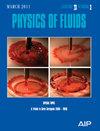海蠓水中运动的力学原理
IF 4.3
2区 工程技术
Q1 MECHANICS
引用次数: 0
摘要
海蠓是一种体型仅为 2 毫米、体重仅为 0.07 达因的微小昆虫,它们为研究先进的运动技术提供了宝贵的资料。这些蠓在台湾垦丁国家公园万里洞的浅礁中被发现,它们能以每秒约 340 个体长的速度连续穿越海水表面超过 90 分钟。它们的飞行主要依靠两种机制:利用表面张力产生推力的振翅和产生气动升力的缩翅。这项研究填补了人们对海蠓如何产生长时间飞行所需的升力和推力的认识空白。我们通过实验测量了它们的重量、速度和翅膀频率,研究了它们独特的运动方式。这些测量结果为三维计算流体动力学(CFD)模拟提供了依据,以分析其中涉及的空气动力。结果凸显了地面效应的关键作用,即保持蠓躯干之间 0.08 毫米和翼尖 0.055 毫米的最小间隙对升力至关重要。此外,超过 300 赫兹的高拍翅频率对于在缩翅过程中产生足够的升力至关重要。我们的研究结果表明,地面效应、前进速度(>60 cm/s)和拍翅频率是海蠓在海面上持续飞行的关键因素。这种对水面运动的独特适应不仅展示了海蠓非凡的飞行能力,也为微型飞行器(MAV)的设计提供了宝贵的启示。本文章由计算机程序翻译,如有差异,请以英文原文为准。
Mechanics of a marine midge water locomotion
Marine midges, tiny insects with a body size of 2 mm and a weight of 0.07 dyn, provide valuable insights into advanced locomotion techniques. Found in shallow reefs at Wanlitong, Kenting National Park, Taiwan, these midges can continuously traverse seawater surfaces for over 90 min at speeds around 340 body-lengths per second. Their flight relies on two primary mechanisms: wing sculling to utilize surface tension for thrust and wing retraction to generate aerodynamic lift. This study addresses the gap in understanding how marine midges generate the lift and thrust needed for prolonged flight. We investigated their unique locomotion by conducting experiments to measure their weight, speed, and wing frequency. These measurements informed 3D computational fluid dynamics (CFD) simulations to analyze the aerodynamic forces involved. The results highlight the critical role of the ground effect, where maintaining minimal gaps of 0.08 mm between the midge trunk and 0.055 mm at the wing tips is essential for lift. Additionally, a high wing-beat frequency exceeding 300 Hz is crucial for generating sufficient lift during wing retraction. Our findings emphasize that ground effect, forward speed (>60 cm/s), and wing-beat frequency are key factors enabling marine midges to sustain flight above the sea surface. This unique adaptation for water surface locomotion not only showcases the midge's remarkable flight capabilities but also offers valuable insights for the design of micro-air vehicles (MAVs).
求助全文
通过发布文献求助,成功后即可免费获取论文全文。
去求助
来源期刊

Physics of Fluids
物理-力学
CiteScore
6.50
自引率
41.30%
发文量
2063
审稿时长
2.6 months
期刊介绍:
Physics of Fluids (PoF) is a preeminent journal devoted to publishing original theoretical, computational, and experimental contributions to the understanding of the dynamics of gases, liquids, and complex or multiphase fluids. Topics published in PoF are diverse and reflect the most important subjects in fluid dynamics, including, but not limited to:
-Acoustics
-Aerospace and aeronautical flow
-Astrophysical flow
-Biofluid mechanics
-Cavitation and cavitating flows
-Combustion flows
-Complex fluids
-Compressible flow
-Computational fluid dynamics
-Contact lines
-Continuum mechanics
-Convection
-Cryogenic flow
-Droplets
-Electrical and magnetic effects in fluid flow
-Foam, bubble, and film mechanics
-Flow control
-Flow instability and transition
-Flow orientation and anisotropy
-Flows with other transport phenomena
-Flows with complex boundary conditions
-Flow visualization
-Fluid mechanics
-Fluid physical properties
-Fluid–structure interactions
-Free surface flows
-Geophysical flow
-Interfacial flow
-Knudsen flow
-Laminar flow
-Liquid crystals
-Mathematics of fluids
-Micro- and nanofluid mechanics
-Mixing
-Molecular theory
-Nanofluidics
-Particulate, multiphase, and granular flow
-Processing flows
-Relativistic fluid mechanics
-Rotating flows
-Shock wave phenomena
-Soft matter
-Stratified flows
-Supercritical fluids
-Superfluidity
-Thermodynamics of flow systems
-Transonic flow
-Turbulent flow
-Viscous and non-Newtonian flow
-Viscoelasticity
-Vortex dynamics
-Waves
 求助内容:
求助内容: 应助结果提醒方式:
应助结果提醒方式:


